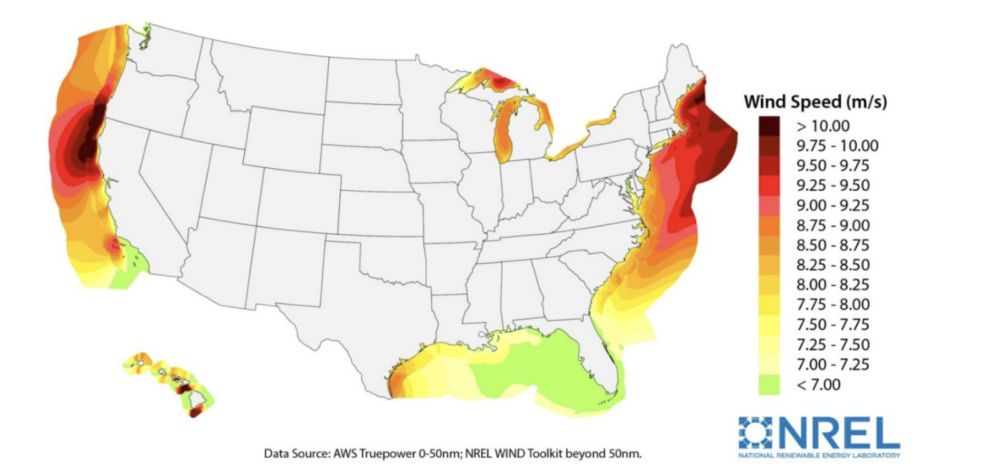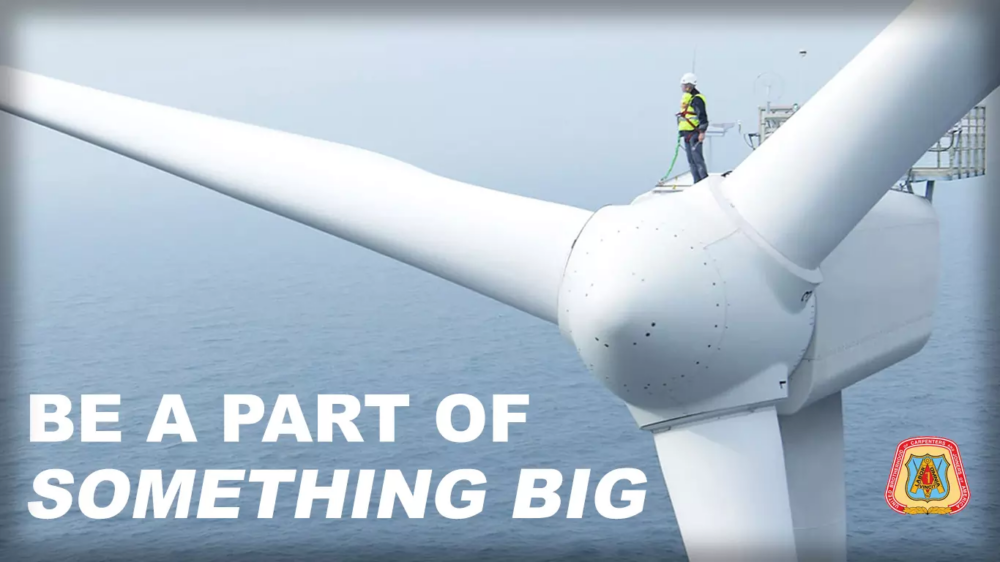Five Ways Offshore Wind Benefits Us All
The Equation Read More [[{“value”:”
Offshore wind is a hot topic these days for a lot of good reasons. While the benefits of the technology are clear to many, it’s worth considering the fuller range from time to time. Here are five reasons offshore wind is a good thing for all of us.
I think most folks understand that wind turbines generate electricity by harnessing the power of the wind (for a handy primer on the mechanics, see here.) Offshore wind turbines work the same way as other turbines, but have the advantage of having access to winds that are generally much stronger and more constant (because the sea, unlike land, has no mountains or other topographic variations that might impede wind flow.)
The United States has abundant offshore wind resources, off the coasts and in the Great Lakes. This includes some of the most-attractive wind resources in the world off both the East and West Coasts. Tapping into that renewable energy is made easier along most of the East Coast and in the Gulf of Mexico by the fact that the water depth is relatively shallow for tens of miles from shore, meaning that the support structures for each turbine can be placed directly on the seabed. And for places where the water gets deep quickly as you move away from land, like off the West Coast and in the Gulf of Maine, floating offshore wind technology is maturing rapidly.
This geography and these technologies mean that offshore wind can be a great resource for meeting electricity demand in our many coastal states, as well as other states and regions connected to them by electric transmission.

Source: NREL
Harnessing abundant offshore wind can bring real benefits for cutting pollution and improving public health. The use of fossil fuels in the power sector, via gas, coal, and oil plants, is a major source of pollutants that harm people and communities. Offshore wind provides a ready solution, with more electricity from offshore wind farms directly leading to less generation from fossil fuel plants.
A recent analysis from research firm Synapse Energy Economics of New England states’ current offshore wind requirements (9,000 megawatts, which would generate enough electricity for more than 4 million households) found that by avoiding emissions of three key pollutants (nitrogen oxides, sulfur dioxides, and particulate matter), the offshore wind would provide almost $400 million in public health benefits each year.
Reducing carbon emissions is another significant benefit of avoiding the burning of fossil fuels with offshore wind. In fact, in some parts of the country, offshore wind may become the largest zero-carbon generation source for cutting power plant carbon emissions and achieving net-zero carbon emissions across the economy. Massachusetts, for example, “anticipates offshore wind will be the primary source of electricity for its decarbonized energy system.” The Synapse analysis projected that New England’s current commitments alone would cut the region’s power plant carbon emissions by more than 40%.
Offshore wind generates even more than clean electrons and pollution reductions: it generates jobs. The economic potential of this technology—both the jobs and the economic development that comes with standing up a whole new industry in this country—is one of the aspects that has many policymakers and their constituents most excited.
Those jobs come from progress in all the different ways that people help make a wind farm a reality. There’s the pre-construction project development work, including surveying to determine where the turbines might go and designing the project. Then there’s the work of manufacturing the various components, such as the cables, foundations, towers, nacelles (the core of each turbine that sits on top of the tower), blades, and all the materials that go into them. There’s the work at the ports to collect all the components and load them for the journey out to sea. There’s the work of putting it all together at each turbine and project site, putting each foundation in place, a tower on each, and a turbine on each tower, and connecting them together. And once it’s turned on, there’s the operations and maintenance work to keep the turbines spinning and the projects producing electrons.

The Carpenters Union is one of the various parts of organized labor excited about offshore wind (Source: Carpenters Local 346)
That manufacturing sector is particularly job-rich. The National Renewable Energy Laboratory has estimated that the push to meet the Biden administration’s goal of 30,000 megawatts could mean that the US offshore wind workforce growing to 15,000-58,000 people. The range depends in large part on how much of the components are made in this country (which in turn depends in large part on the degree to which states and the federal government send clear signals about how much we value offshore wind). Labor unions and supporters have highlighted the importance of the manufacturing opportunities in particular for creating high-paying US jobs—and have urged states to dramatically increase their offshore wind targets to help realize this potential.
Port revitalization is another important benefit of offshore wind. New Bedford, MA, was the first in the nation to equip itself as a staging area for towers, turbines, and more. Various other ports have followed suit as states have compete to put out attractive welcome mats for all the economic development that comes with being a center of offshore wind activity.
The positive effects of offshore wind aren’t limited to coastal areas near a project’s site, or even to the states served by the electricity. Some offshore wind project components are already being manufactured in various parts of the country. And the first American-made offshore wind installation vessel, built in Texas with steel from Alabama, North Carolina, and West Virginia, was launched a few months ago; it’ll be put into service this year off Virginia. Dozens more ships are being built or retrofitted to be part of the offshore wind revolution.
While offshore wind power can’t be turned on with the flip of a switch, it does provide a relatively steady supply of electricity. Offshore wind projects can have high capacity factors—a measure of the portion of the year a project generates. With current technologies, those capacity factors can be close to 50% where the winds are strongest.
More importantly, for coastal regions with cold winters, is when that offshore wind electricity is most abundant. Wind is often strongest when cold weather systems move in, increasing the demand for energy to keep us warm and the lights on. In fuel-limited regions like New England, power plants can run out of gas or oil, as my colleague Susan Muller detailed here, with a case from New England in 2018.
As it happens, that same wind is really good at spinning offshore wind turbines. More electricity from them means less call for electricity from conventional power plants—which, in turn, reduces the risk that those power plants will run out of fuel supply. As Muller showed with her analysis of what abundant offshore wind capacity would have meant in New England during that winter and over two decades of winters, “The timing of that energy delivery, when the grid is strained by high demand and fuel supply challenges, makes it especially valuable as a way to maintain winter reliability.” More offshore wind means greater reliability.
Offshore wind can also have important, beneficial implications for energy costs. All of the projects already in operation or under construction are tied to specific contracts with utilities for the electricity they’ll produce over many years. While the contract prices were considerably higher under more recent contracting, given increases in the costs associated with financing, constructing, and maintaining the later projects, they still provide considerable value—or even overall savings. That’s largely because fossil gas generally drives overall electricity prices, fossil gas prices fluctuate wildly in response to weather or geopolitical circumstances, and offshore wind displaces fossil gas use.
The recent Synapse assessment of near-term offshore wind targets for New England, using an average of the lower and higher contract costs to date, projected cost savings for electricity customers in the region. With 9,000 megawatts of offshore wind, they found net electricity cost savings could average $630 million a year under a mid-case gas price scenario—or more than $1 billion in a high-gas scenario.
The utility behind the largest US offshore wind project, currently under construction off Virginia, recently said that if the project had been in operation when Winter Storm Elliot hit in 2022, it would have saved customers $10 million in a single day. Over the first 10 years of the project’s operation, they expect to save $3 billion from avoided fuel expenses.
As Susan Muller has explained, having offshore wind for winter reliability can also avoid costly and polluting options for reliability, like the ones that New England’s regional grid operator had turned to: “…the resource is big enough that it can provide winter reliability benefits on a scale that could allow us to stop subsidizing oil and gas just to keep the lights on in winter.”
So many benefits. But offshore wind doesn’t just happen. Here are a few ways you can help:
- Push for strong offshore wind targets. Given the incoming US president’s lack of appreciation for the incredible opportunities offshore wind power represents, states will need to be even bigger drivers of progress on offshore wind. State requirements have been major drivers of action in this space, and stronger state requirements will help make up for any slowdown in federal progress in the next few years.
- Be a force for offshore wind done right. Just as important as strong targets is strong ambition in how the offshore wind development happens. States have included some good environmental, equity, and labor standards in more recent offshore wind legislation, and more action on those fronts will be important for maximizing benefits for all.
- Support good decision making. Whilefederal and state action is key, so are good decisions around offshore wind projects at more local levels. City and town governments, for example, have public comment opportunities when considering approving an offshore wind project’s cable, necessary for getting the electricity to where we need it. Whether you have a background in a particular aspect of the matter at hand, or knowledge of the area, your perspective is important.
- Help combat misinformation. Offshore wind has operated well for decades elsewhere in the world, and projects here go through years of rigorous study to make sure the net benefits are as strong as possible. But you wouldn’t know that based on disinformation pushed by the fossil fuel industry about the technology and projects’ supposed effects on endangered wildlife. Researchers at the Brown University Climate and Development Lab traced the network of dark money behind the recent burst of local offshore wind opposition groups and how dishonest claims have made their way into Congress. While some people who repeat these false claims don’t realize they’ve been duped, ultimately spreading bad information works to the benefit of fossil fuel companies at the expense of our public health and economy. A good way to combat misinformation is ask where the information is coming from, and who is backing those sources. And a good strategy is not to repeat or pass on those dubious or false claims, via social media, for example.
And in these challenging times, one more thing you can do to is to celebrate and help highlight the real progress we are making. Last year saw the first commercial-scale US offshore wind project come online. While that project brought the US total to only 174 megawatts, another 6,000 megawatts are under construction. Several other projects are through the federal permitting process. Thousands of people are working in offshore wind in this country. And millions of people, including in coastal areas, recognize the value a whole lot more offshore wind will bring.
“}]]
